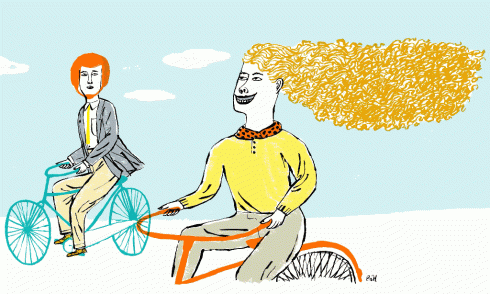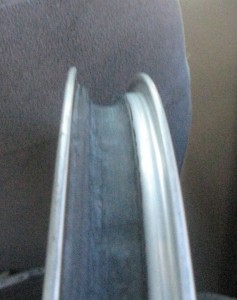I knew I’d have a problem with the film just based on the the title.
There can be animosity between people on bikes and in cars, but bikes and cars are machines, which have no feelings and generally don’t get into trouble unless a person is behind the steering wheel or the handlebars. The title “Bikes vs. Cars” reminds me of a frequent complaint of bicyclists who have had incidents in traffic, “the car didn’t see me.” The title and that statement both reflect a fear-based mental block which has led to the inability to conceive of the car as a machine under control of a human, with whom it is possible to interact, and so, much more often, to avoid incidents…
Enough. There’s more to say. My Facebook friend Kelley Howell has posted a detailed review, which follows here:
***************
Why I think the film, Bikes Vs. Cars, is a waste of money:
by Kelley Howell
It was a scattered, gawky film filled with untenable contradictions. Some thoughts:
The film switched back and forth between a desire to own the streets and use them as if they belonged to bicyclists who have a right to drive on them, free of cars, but then it dropped its pretense to militancy asking for small slivers of space on the edge, as if if that edge were some Magic Kingdom of safety. On one hand, the people in the film seem to be demanding a right to take the entire road and get the hated cars off it. On the other hand, it’s all about scampering out of the way, deferring to a dominant majority no one knows how to handle, let alone challenge.
As an example, there was a line in the film which went something like this: “At 1 AM, during the quiet of Carmeggedon in LA. I sneaked on to the 405 and rode my bike on this massive highway. It was beautiful. I owned that feat of human engineering. For the first time, I felt it was a marvel of human engineering that was made for me.”
Then they switch to Sao Paulo in Brazil, to capture the happy reactions of bicyclists who learned that the city is laying down 100s of kilometers of too narrow bike lanes in a very congested city where few people appear to follow traffic law to begin with. I was hard pressed to imagine all these scrappy motorists would respect the painted lines of a 4 foot wide gutter bike lane.
Which is it: do you want to drive a bike on that feat of human engineering, the 405, or a 4 foot bike lane with cars passing too close, driving out into your path, and right- and left-hooking you constantly? How is that demanding your rights? How is it safe? Accepting a scrap of asphalt, some of it carved out of a gutter built for sewer water? After all that rhetoric of wanting access to feats of human engineering, how is that you want to operate in a gutter bike lane?
The film trades in the imagery of the bicyclist, rolling free, free of motorists, free of the burden of a body on pavement, free because it can dodge the confines of hated “traffic”. The magic of the bicycle is its thrift, its speed, and its nimble ability to slip through crevices of urban congestion. It is at once traffic and the supposed escape from it.
But this is reminiscent of the propaganda that dominates the most pedestrian – har! – of auto advertisements where cars mean freedom, an open road, an endless horizon. This imagery in commercials is a stark counterpoint to the reality of miles of congested freeway, gridlock, and, well, to borrow a phrase, the hell that is other motorists at rush hour.
This trope — the bicycle as freedom, magically evading being captured in traffic — is present in an amusing fantasy entertained in the film: pulling 20% of all motorists off the Los Angeles roads and reinserting them with their derrieres planted in bike saddles. Apparently they will accomplish their 14.7 mile commute on their Dutchie or Cruiser, pedaling along at 10 mph?
Going by LA county numbers, 20% of the ~4.5 million motoring commuters is 900,000 bicyclists. Even if their commute where far shorter – say a manageable 5 miles at 10 mph — that’s a lot of bicyclists who get to share those four foot wide gutter bike lanes. Good luck with that!
Then, there was a main protagonist, name escapes, in Brazil. She says, to paraphrase, “What I want is some respect for human cooperation.” And then the film plugs away about the lack of bike lanes. Having apparently conceded that motorists will NOT actually give bicyclists that respect or cooperatively share the roads, they ask for a sliver of space in the gutter.
Which is fine. Really. If that’s what you want. But don’t imagine segregating modes is about cooperating. It’s rather about demanding public resources be spent on gutter-based infrastructure in Brazil precisely because motorists WILL NOT share the road. No one has actually changed the domination of motorists. In this “victory,” existing configurations of power remain the same, leaving bicyclists just as powerless as they always were, only now they are marginalia set off by 6 inch stripes of paint.
The incident with the Dutch cab driver was high camp and deserves its own post. It was my impression that the cabbie staged the whole thing, a real drama queen pining for his 5 minutes on camera. Basically, it was exemplary of what Nietzsche called a transvaluation of values[1]: an opportunity for bicyclists everywhere to make the motorist suffer for a change[2].
The problem is that this is an exercise in punishing schadenfreude. We are all supposed to love it that the roles have reversed in the Netherlands. The taxi driver has to be troubled, delayed, and dominated by the majority, bicyclists. We get to engage in gleeful enjoyment to see him upset, angry, cowed by the throngs of bicyclists blocking his every move. There! Take That, you bad, bad motorists. How do you think it FEELS to be marginalized like we were?
This is a stupid and shameful sentiment that shouldn’t be tolerated by anyone doing bicycling advocacy. But it is, unfortunately, celebrated by too many participation advocates – including this film, which trades in cheap theatrics and, well, quite frankly, trashy propaganda. At least have the decency to be sophisticated about it if you are going to trade in such infantilizing sentiments.
[1] I am unhappy with the choice of ‘transvaluation of values’ to express what I mean here. But it’s been a longass day. Tant pis!
[2] As for the transvaluation of values thing, for more detail on the problems with this position, see Wendy Brown’s work States of Injury: Power and Freedom in Late Modernity. Here, Brown captures the problem as one where, basically, an oppressed or marginalized group rises in power and status, promoting a compulsion to repetition rather than liberation:
“Initial figurations of freedom are inevitably reactionary in the sense of emerging in reaction to perceived injuries or constraints of a regime from within its own terms. Ideals of freedom ordinarily emerge to vanquish their imagined immediate enemies, but in this move they frequently recycle and reinstate rather than transform the terms of domination that generated them. Consider exploited workers who dream of a world in which work has been abolished, blacks who imagine a world without whites, feminists who conjure a world either without men or without sex, or teenagers who fantasize a world without parents. Such images of freedom perform mirror reversals of without transforming the organization of the activity through which the suffering is produced and without addressing the subject constitution that domination effects, that is, the constitution of the social categories, “workers,” “blacks,” “women,” or “teenagers.”
It would thus appear that it is freedom’s relationship to identity-its promise to address a social injury or marking that is itself constitutive of an identity that yields the paradox in which the first imaginings of freedom are always constrained by and potentially even require the very structure of oppression that freedom emerges to oppose.”







